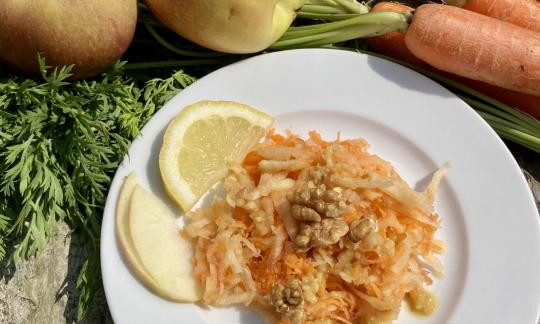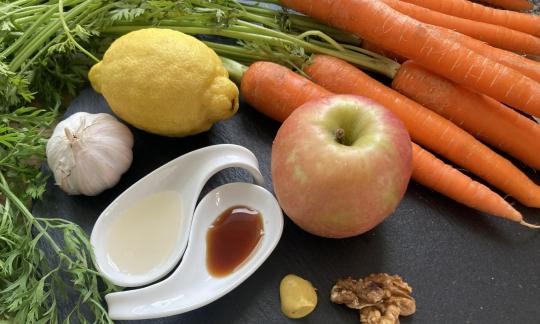Quick healthy, oil-free carrot salad
raw-vegan
Ingredients (for servings, )
| For the salad base | |
|---|---|
| 4 | Carrots (carrots), raw (organic?) (8.6 oz) |
| 1 | Lemons, raw (limes, organic?) (2.0 oz) |
| 1 | Apple, raw, with peel (5.3 oz) |
| For the dressing | |
| 1 clove | Garlic (organic?) (0.11 oz) |
| 1 tbsp | Balsamic vinegar, white (Condimento bianco, organic?, raw?) (0.56 oz) |
| 2 tsp | Reduced salt soy sauce (Genen-Shoyu, organic?, raw?) (0.37 oz) |
| 1 tsp | Mustard (Mostert, Mostrich, raw?, organic?) (0.18 oz) |
| 1 oz | Walnuts (tree nuts), raw (organic?) |
Equipment
- grater
- garlic press
- citrus juicer (lemon squeezer)
Type of preparation
- chop or grind
- food preparation without heating
- squeeze
- remove the skin
- grate (shred)
Preparation
For the salad
Clean the carrots and grate them finely. If using apple (optional!), wash it and grate it coarsely. Squeeze the lemon. Mix everything together.If you use organic carrots, it is enough to scrape off the skin. Otherwise, peel the carrots. We used carrots that weighed 80 g each. The quality of the carrots is crucial here. Preferably use fresh organic carrots that have a sweet taste.
If you use apple, it is best to add the lemon immediately after grating the apple so that it does not turn brown.
For the dressing
Peel and press the garlic. Add balsamic vinegar, soy sauce and mustard and mix everything together.Finish the salad
Add the dressing to the salad and mix everything together. Optionally, sprinkle with roughly chopped walnuts and serve.
|
Nutritional Information per person
Convert per 100g
|
2000 kcal | |
|---|---|---|
| Energy | 213 kcal | 10.7% |
| Fat/Lipids | 10 g | 14.9% |
| Saturated Fats | 1.0 g | 5.1% |
| Carbohydrates (inc.dietary fiber) | 30 g | 11.0% |
| Sugars | 17 g | 18.5% |
| Fiber | 7.2 g | 28.8% |
| Protein/Albumin | 4.6 g | 9.2% |
| Cooking Salt (Na:281.5 mg) | 715 mg | 29.8% |
| Essential micronutrients with the highest proportions | per person | 2000 kcal | |
|---|---|---|---|
| Vit | Vitamin A, as RAE | 1'022 µg | 128.0% |
| Fat | Alpha-Linolenic acid; ALA; 18:3 omega-3 | 1.4 g | 69.0% |
| Fat | Linoleic acid; LA; 18:2 omega-6 | 5.9 g | 59.0% |
| Min | Manganese, Mn | 0.76 mg | 38.0% |
| Prot | Threonine (Thr, T, irreversibly transaminated) | 0.33 g | 36.0% |
| Sodium, Na | 281 mg | 35.0% | |
| Min | Copper, Cu | 0.33 mg | 33.0% |
| Vit | Vitamin C (ascorbic acid) | 27 mg | 33.0% |
| Vit | Vitamin B7 (Biotin, ex vitamin H) | 15 µg | 31.0% |
| Elem | Potassium, K | 587 mg | 29.0% |
Detailed Nutritional Information per Person for this Recipe
The majority of the nutritional information comes from the USDA (US Department of Agriculture). This means that the information for natural products is often incomplete or only given within broader categories, whereas in most cases products made from these have more complete information displayed.
If we take flaxseed, for example, the important essential amino acid ALA (omega-3) is only included in an overarching category whereas for flaxseed oil ALA is listed specifically. In time, we will be able to change this, but it will require a lot of work. An “i” appears behind ingredients that have been adjusted and an explanation appears when you hover over this symbol.
For Erb Muesli, the original calculations resulted in 48 % of the daily requirement of ALA — but with the correction, we see that the muesli actually covers >100 % of the necessary recommendation for the omega-3 fatty acid ALA. Our goal is to eventually be able to compare the nutritional value of our recipes with those that are used in conventional western lifestyles.
| Essential fatty acids | per person | 2000 kcal |
|---|---|---|
| Alpha-Linolenic acid; ALA; 18:3 omega-3 | 1.4 g | 69.0% |
| Linoleic acid; LA; 18:2 omega-6 | 5.9 g | 59.0% |
| Essential amino acids | per person | 2000 kcal |
|---|---|---|
| Threonine (Thr, T, irreversibly transaminated) | 0.33 g | 36.0% |
| Tryptophan (Trp, W) | 0.04 g | 17.0% |
| Isoleucine (Ile, I) | 0.20 g | 16.0% |
| Leucine (Leu, L) | 0.32 g | 13.0% |
| Valin (Val, V) | 0.22 g | 13.0% |
| Phenylalanine (Phe, F) | 0.19 g | 12.0% |
| Lysine (Lys, K, irreversibly transaminated) | 0.21 g | 11.0% |
| Methionine (Met, M) | 0.06 g | 7.0% |
| Vitamins | per person | 2000 kcal |
|---|---|---|
| Vitamin A, as RAE | 1'022 µg | 128.0% |
| Vitamin C (ascorbic acid) | 27 mg | 33.0% |
| Vitamin B7 (Biotin, ex vitamin H) | 15 µg | 31.0% |
| Vitamin K | 18 µg | 24.0% |
| Vitamin B6 (pyridoxine) | 0.32 mg | 23.0% |
| Vitamin B9, B11 (Folate, as the active form of folic acid) | 44 µg | 22.0% |
| Vitamin B1 (Thiamine) | 0.16 mg | 15.0% |
| Vitamin B2 (Riboflavin) | 0.12 mg | 9.0% |
| Vitamin B3 (Niacin) | 1.5 mg | 9.0% |
| Vitamin B5 (Pantothenic acid) | 0.54 mg | 9.0% |
| Vitamin E, as a-TEs | 1.1 mg | 9.0% |
| Essential macroelements (macronutrients) | per person | 2000 kcal |
|---|---|---|
| Sodium, Na | 281 mg | 35.0% |
| Potassium, K | 587 mg | 29.0% |
| Phosphorus, P | 112 mg | 16.0% |
| Magnesium, Mg | 46 mg | 12.0% |
| Calcium, Ca | 71 mg | 9.0% |
| Essential trace elements (micronutrients) | per person | 2000 kcal |
|---|---|---|
| Manganese, Mn | 0.76 mg | 38.0% |
| Copper, Cu | 0.33 mg | 33.0% |
| Iron, Fe | 1.1 mg | 8.0% |
| Zinc, Zn | 0.84 mg | 8.0% |
| Selenium, Se | 2.0 µg | 4.0% |
| Iod, I (Jod, J) | 5.3 µg | 4.0% |
| Fluorine, F | 7.2 µg | < 0.1% |
The quick, healthy and oil-free carrot salad is particularly rich in vitamin A.
Quantity: The specified quantity of 2 portions is sufficient for a main course for 2 people or a starter or side dish for 4 people.
Nutrient profile: According to GDA guidelines, one portion of the low-calorie salad covers well over 100% of the average daily requirement of vitamin A. If walnuts are used, it also contains 70% of the omega-3 fatty acids. The ratio of omega-6 to omega-3 fatty acids is then 4:1, below the maximum recommended ratio of 5:1.
You can find further information on this topic at the following link: Vegans often eat unhealthily. Avoidable nutritional errors.
Carrots and carotenes: Carrots are popular as a low-calorie raw food and are known primarily for their high carotene content. Carotenes are fat-soluble, secondary plant substances. The best-known representative is so-called beta-carotene, which gives the carotene group its name and is also an important precursor in the body's own production of retinol (vitamin A). For this reason, it is also called pro-vitamin A.
In plants, carotenoids are used for photosynthesis and protection against UV radiation, while their formation in plant roots protects against infections.
While the cancer-protective effects of beta-carotenes in humans are the starting point of many debates, there is agreement regarding their cell-protective effect as antioxidants.
Walnut: The real walnut, also called tree nut, has the highest proportion of linolenic acid (an omega-3 fatty acid that is good for the heart) of all nuts. It also has health benefits thanks to tocopherols (forms of vitamin E) and many macro and trace elements.
Preferably use fresh organic products that you only need to wash and do not need to peel.
Storing carrots: It is best to store the carrots unwashed and without the leaves, wrapped in a damp tea towel in the vegetable compartment of the refrigerator. This way they will last for a good week.
The use of walnuts is optional. However, the salad without walnuts contains almost no omega-3 fatty acids, whereas with walnuts it covers almost 70% of the average daily requirement per portion. Carotenes are also fat-soluble, which is why a certain amount of fat promotes absorption. Fine grating and good chewing also lead to improved absorption.
You can prepare the salad without apple, which will make it taste a little less fruity.






